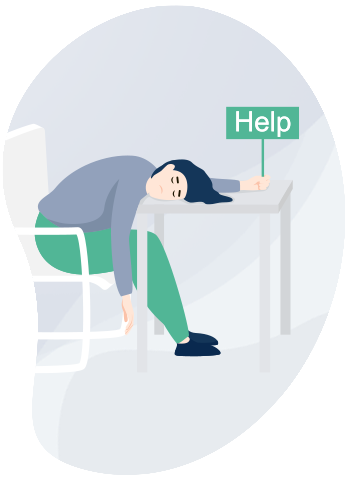Occupational burnout as an occupational syndrome has recently been included in the International Classification of Diseases. How can you avoid it? Do you work in a profession particularly exposed to this syndrome? In this article you will learn information and tips on how to recognize the symptoms of professional burnout in yourself, and you will find out what actions you should take to counteract this phenomenon.
What is professional burnout?
Definition of job burnout
Professional burnout is a state of emotional, mental and physical exhaustion. It is caused by long-term stress, often resulting from excessive demands at work, i.e. overtime and constant pressure. Recognizing the symptoms of burnout is crucial to maintaining well-being and productivity in the workplace.
More information on the definition of professional burnout can be found here: the definition of professional burnout can be found here: [CLICK]
Research on occupational burnout
This problem is really common and affects workers all over the world. According to a Gallup survey of nearly 7,500 full-time employees in various countries, approximately 23% of employees reported feeling burnt out very often or all the time, while an additional 44% responded that this problem only occurs occasionally.
EU research reveals that the COVID-19 pandemic has had a significant impact on stress and burnout in workplaces around the world. During this time, many employees faced increased job demands, uncertainty and the challenges of working remotely.
Situation in Europe
According to the European Agency for Safety and Health at Work, work-related stress and, consequently, burnout affect a significant number of European workers. A study by EU-OSHA estimated that around 22% of people working in the EU reported experiencing work-related stress. These problems also appear in Poland. According to a study conducted by the Nofera Institute of Occupational Medicine, approximately 23% of Polish employees were at risk of burnout, with the highest risk observed among health professionals, teachers and people working in the service industry.
Are you at risk of professional burnout? Causes and symptoms
There can be many causes of professional burnout, according to research by Kronos Incorporated and Future Workplace, the following factors were influential:
– inadequate remuneration (41%),
– work overload (32%),
– overtime (32%),
– ineffective management in the company (30%),
– no connection between the employee’s role and the company’s strategy (29%),
– low work culture (26%).
A high risk of professional burnout is created by working in professions that require frequent and long social interactions with other people or working in difficult conditions. These can be, for example, medical professions, psychologists, recruiters, all kinds of services or people working in education.
Practical examples of burnout symptoms may include:
Physical exhaustion: Feeling constantly tired and lacking in energy, even after adequate rest and sleep. Physical symptoms can include headaches, muscle tension, and a weakened immune system, leading to frequent illnesses.
Emotional detachment/indifference: Experiencing feelings of emotional detachment and indifference to work and co-workers. Employees may become emotionally numb and show a lack of enthusiasm or empathy in their social interactions and in approaching responsibilities they previously performed with commitment.
Decreased Productivity: Experiencing a decline in professional performance despite putting in significant effort at work. This leads to a reduction in the sense of accomplishment and job satisfaction, as well as mental discomfort.
Cynicism and Negativism: Developing a negative outlook on work-related matters that may extend to co-workers, clients, or the entire organization. Such a pessimistic attitude can affect work relationships and team dynamics.
Loss of motivation: Loss of enthusiasm and motivation for work, leading to a lack of interest in tasks that were once rewarding and enjoyable. It is also associated with the lack of setting goals or plans for further development: stagnation.
Increased irritability: Becoming easily frustrated or irritable, even over minor issues, and experiencing greatly reduced tolerance to any work-related stressors.
Withdrawing from social interaction: Avoiding social interaction and isolating oneself from colleagues and friends, leading to feelings of loneliness and alienation.
Cognitive Difficulties: Difficulty concentrating, memory lapses, and impaired decision-making abilities, leading to reduced efficiency and productivity.
Increased absenteeism: An increase in sick leave and absences due to both physical and emotional health issues caused by burnout.
Escape Behavior: Engaging in escape behavior such as excessive use of alcohol or drugs, excessive screen time, or engaging in compulsive activities to distract from work-related stress.
Lack of self-care: Neglecting self-care practices such as exercise, proper nutrition, and adequate sleep and sleep hygiene can exacerbate burnout symptoms.
Let’s not forget that each case of occupational burnout should be considered individually. Reaching for help should take place as early as possible. The basic step will be education, what to pay attention to in order to consciously monitor your well-being.
How to counteract occupational burnout – prevention:
Is it possible to prevent professional burnout? Prevention plays the first fiddle here. What can you do to take care of yourself and your wellbeing and feel better during a stressful time? There are several ways to do this.
Ways to counteract professional burnout:
Setting boundaries in your professional and personal life: Set clear boundaries between your work and personal life. Avoid frequent extension of working hours, set aside time for rest, your hobbies or a moment for your loved ones. Be assertive and prioritize your needs.
Time management: Work on your time management skills to effectively prioritize your tasks. Break larger projects down into smaller, more manageable parts and use productivity techniques.
Take regular breaks: Take short breaks throughout the workday to rest and recharge your batteries. It can be a walk, drinking tea without using any devices, stretching or breathing exercises.
Supporting others: Build a support network at work and/or in your personal life. Talk about everyday difficulties, stress, it will bring you relief and possibly valuable insights.
Mindfulness: You can practice your mindfulness through, for example, meditation or yoga, they will reduce stress and increase self-awareness.
Physical activity: It’s not just about improving your health. Physical activity releases endorphins that improve mood and reduce stress.
Healthy eating habits: Keep your diet balanced. Healthy eating plays a key role in well-being and, above all, health.
Vacation: Use your vacation days to rejuvenate your body and mind.
Professional development: Bet on the development of your skills, invest in learning, cultivate your interests.
Sleep hygiene: take care of your sleep. Keep a consistent schedule of bedtime and wake up times. Try to get at least 7-9 hours of sleep a night so that your body has time to regenerate.
Take a break from technology: limit the time you spend in front of screens, set limits, e.g. through time limits in specific applications. Sign out of work accounts on personal devices.
Of course, you don’t have to use all of these activities, adapt them to your lifestyle and the needs of your body. Only you know best how you feel and what actions help you.

